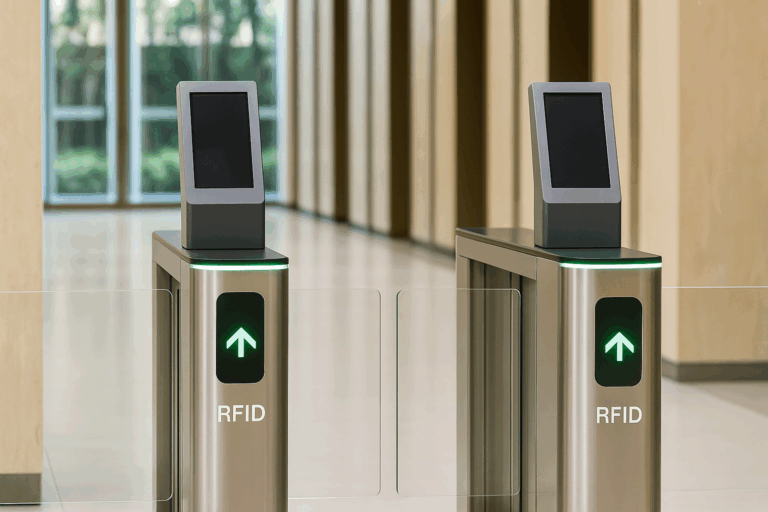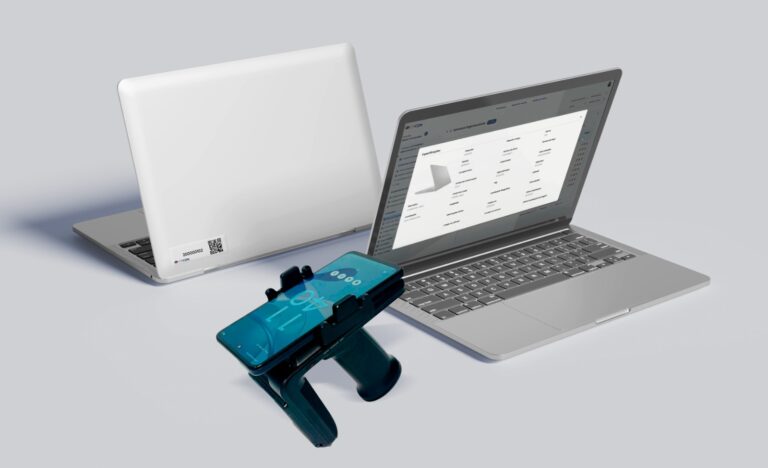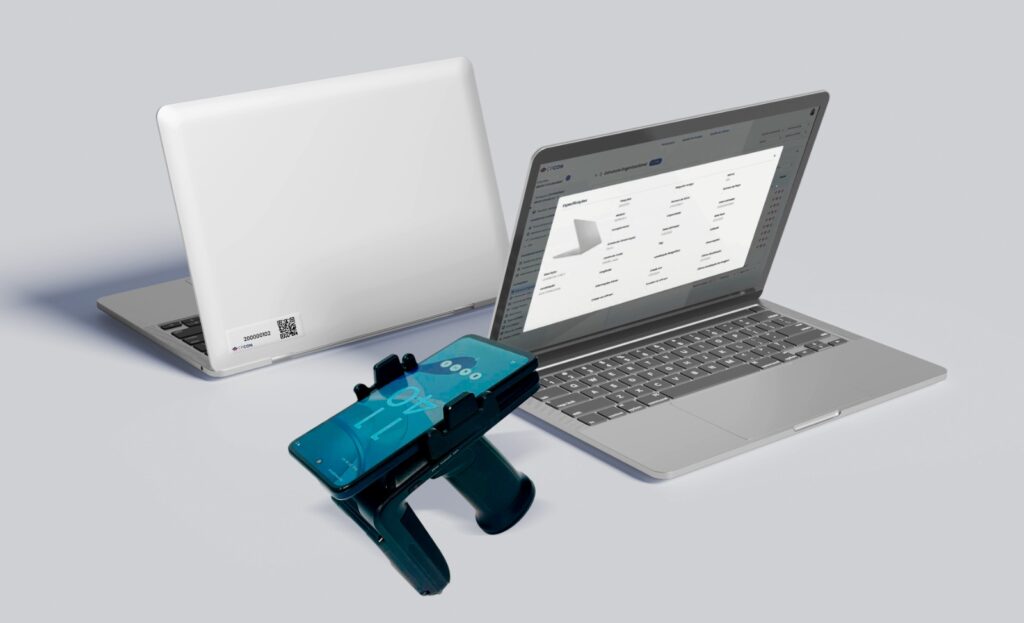Table of Contents
ToggleProtect high-value jewelry with advanced RFID anti-theft tags. Discover how to reduce shrinkage, control inventory in real time, and build customer trust
RFID anti-theft tags for jewelry are the most effective way to protect high-value items in retail environments. These intelligent tags not only prevent theft but also enable real-time inventory tracking, giving retailers full control over their assets.
With theft and shrinkage on the rise—especially in luxury segments—investing in RFID-based anti-theft technology is no longer optional. Jewelry stores that rely solely on traditional methods are exposed to operational losses, reputational risk, and customer dissatisfaction.
In this guide, you’ll understand:
- What RFID anti-theft tags for jewelry are and how they work;
- The different types of security tags used in high-end jewelry retail;
- How to integrate these solutions into your store without disrupting customer experience;
- And why RFID is the most cost-effective way to secure, monitor, and scale your operations.

What Are RFID Anti-Theft Tags for Jewelry?
RFID anti-theft tags for jewelry are smart security devices designed to protect high-value items while ensuring seamless retail operations. Unlike basic security tags used for apparel or electronics, these tags are engineered specifically for the unique needs of jewelry stores — where small size, delicate design, and high monetary value require extra precision.
Key Features:
- Radio-Frequency Identification (RFID): Enables real-time tracking and detection across the store.
- Tamper-proof locking systems: Prevent unauthorized removal of the tag without a detacher tool.
- Discreet, aesthetic design: Integrates seamlessly with displays without compromising the visual appeal of luxury items.
These tags combine security and intelligence. They not only sound alarms when tampered with or removed, but also transmit critical data to inventory systems — helping retailers monitor stock levels, identify losses, and detect unusual patterns in real time.
Why RFID Over Traditional Tags?
Traditional tags rely on magnetic or ink-based deterrents and offer no data or automation. RFID anti-theft tags, on the other hand:
- Automate inventory checks;
- Enable smart alerts and remote monitoring;
- Improve asset visibility across multiple store locations.
For luxury retail, this means fewer errors, tighter control, and a better customer experience — all in one scalable solution.
Types of Anti-Theft Tags for Jewelry: Choosing the Right Solution
Not all jewelry requires the same level of protection. Different types of anti-theft tags offer distinct advantages depending on the design, material, and value of the item. Choosing the right tag ensures both effective security and a smooth customer experience.
Hard Tags
Best for: High-value items like diamond rings, watches, and luxury earrings.
Hard tags are made from durable plastic or composite materials and are designed to be nearly impossible to remove without a special detacher. Their physical strength and tamper resistance make them ideal for premium pieces.
Benefits:
- Maximum theft deterrence
- Visible protection (psychological barrier)
- Reusable and durable
Soft Tags
Best for: Lightweight or delicate items like chains, necklaces, and bracelets.
Soft tags are more flexible and often adhesive-based, which allows for discreet application without affecting the jewelry’s appearance. They’re perfect for designs that can’t support heavy or bulky tags.
Benefits:
- Flexible fit and low profile
- Lightweight and gentle on sensitive materials
- Cost-effective for medium-range pieces
RFID-Based Tags
Best for: Stores seeking full inventory control and security integration.
RFID tags bring the highest level of intelligence to anti-theft systems. They transmit real-time data to backend systems, allowing inventory to be tracked automatically — from display to point of sale.
Benefits:
- Real-time tracking and loss alerts
- Integration with inventory and ERP systems
- Supports compliance and audits
Benefits of Using RFID Anti-Theft Tags in Jewelry Stores
Investing in RFID anti-theft tags goes far beyond theft prevention — it’s a strategic move that improves efficiency, transparency, and customer satisfaction. Here’s how this technology transforms jewelry retail operations:
1. Stronger Theft Deterrence
RFID tags are designed to trigger alerts the moment unauthorized movement is detected. Unlike conventional tags, RFID-based systems cover the entire store perimeter, reducing blind spots and stopping theft attempts before they happen.
What it means for your store:
- Reduced shrinkage
- Real-time alerts to staff and security teams
- Clear deterrent for internal and external theft
2. Real-Time Inventory Accuracy
Every tagged item becomes part of a live inventory network. RFID readers automatically count items on display, in storage, or in transit — eliminating the need for manual stocktaking and reducing human error.
Results:
- Accurate stock levels at all times
- Faster audits and reconciliations
- Better decision-making based on reliable data
3. Improved Customer Experience
Customers value security, but they also expect elegance and fluidity in luxury shopping. RFID tags ensure protection without compromising the visual appeal of the display or interrupting the buying process.
Impacts:
- Seamless displays with discreet tags
- Faster checkout (tags can be read without contact)
- Greater trust and confidence from customers
4. Operational Efficiency
RFID streamlines multiple processes: from inventory updates to loss investigations and restocking routines. This saves time for staff and reduces overhead costs over time.
Business advantages:
- Optimized staff allocation
- Lower labor costs in inventory control
- Scalable for chain or multi-store retailers
5. Compliance and Audit-Readiness
With complete traceability and historical data, RFID systems support compliance with internal policies and external regulations. For jewelers operating in multiple countries or under strict reporting rules, this is critical.
What you gain:
- Easy generation of audit trails
- Compliance with tax, insurance, and regulatory standards
- Peace of mind in every inspection
Want to see how RFID technology actually works in a jewelry store?
Watch this demonstration of real-time tracking, anti-theft tagging, and inventory automation in action.

How to Choose the Right RFID Anti-Theft Tags for Your Store
Selecting the right RFID anti-theft tags for your jewelry store requires more than just picking a model off the shelf. It’s about aligning technology with your store’s layout, product range, and risk profile. Here’s how to make an informed decision:
1. Assess the Type and Value of Your Jewelry
Not all jewelry needs the same level of protection. The type, material, and average ticket value should determine which tag you use.
| Jewelry Type | Recommended Tag Type | Reason |
| High-value pieces (e.g., diamond rings, watches) | Hard RFID Tags | Maximum protection and tamper resistance |
| Delicate items (e.g., chains, pendants) | Soft RFID Tags | Lightweight, discreet, gentle on materials |
| Large inventories (multiple SKUs) | Integrated RFID Labels | Speed and automation for stock management |
2. Ensure Compatibility with Your Systems
Your existing infrastructure — like ERP, POS, or EAS — must integrate with the new RFID setup. Always verify if the tags and readers are interoperable with your software and hardware.
Key checkpoints:
- Tag frequency (UHF / HF / NFC)
- Reader range and coverage
- Integration with backend platforms (SAP, Oracle, etc.)
3. Balance Budget and ROI
While premium RFID tags may have a higher upfront cost, they deliver measurable long-term value by reducing shrinkage, labor costs, and manual errors.
Tip: Start with your most vulnerable inventory or high-value sections. Then scale gradually based on results and store complexity.
4. Consider Design and Customer Experience
Tags should complement — not interfere with — the aesthetic appeal of your displays. Choose solutions that are discreet, reusable, and easy to deactivate at checkout.
5. Work with a Strategic Partner
Choosing the right tags is only half the equation. Implementation, training, and optimization are what turn RFID into a real business advantage.
That’s why many retailers turn to experts who understand not just the technology — but the business side of jewelry security.
Best Practices for Tag Installation, Staff Training, and Maintenance
Deploying RFID anti-theft tags in a jewelry store isn’t just about the hardware — it’s about how well the system is installed, maintained, and used by your team. A successful implementation ensures long-term protection, operational efficiency, and customer trust.
1. Proper Tag Installation
Tag placement must be precise. Each jewelry item requires a balance between visibility for security and discretion for visual presentation. Poor installation can compromise detection or even damage delicate pieces.
Recommendations:
- Use non-invasive attachment methods suited to the item’s material
- Avoid tagging areas with stones, clasps, or fragile finishes
- Calibrate readers to ensure full coverage of entrances and exits
Consider professional installation for optimal tag positioning and system performance.
2. Staff Training and Engagement
Even the most advanced system fails without trained staff. Your team needs to understand how RFID works, how to handle tags, and how to respond to security alerts.
Training should include:
- How to apply and remove tags safely
- How to interpret RFID reader alerts
- What to do in case of an alarm trigger
- Protocols for handling suspicious behavior
Training also reinforces staff accountability, reducing internal shrinkage.
3. Ongoing System Maintenance
Like any critical infrastructure, RFID systems require regular checks. Over time, tags can wear out, readers may need recalibration, and software updates may become necessary.
Routine tasks:
- Inspect and test tag integrity during stock audits
- Clean and test antennas and readers
- Review system logs for anomalies
- Keep software and firmware up to date
Proactive maintenance ensures continuous performance and reduces downtime.
4. Aligning with Operational Workflows
Your security process should never slow down your business. RFID tagging must integrate smoothly into your sales, inventory, and visual merchandising operations.
Key practices:
- Define roles and responsibilities (e.g., who tags new arrivals)
- Create a checklist for opening and closing procedures
- Synchronize inventory management systems with RFID logs
This alignment enhances productivity and minimizes friction in daily operations.
Legal Compliance and Customer Trust in RFID Security Systems
Implementing RFID-based security in a jewelry store isn’t just a technological decision — it’s a legal and ethical responsibility. Customers expect their privacy to be respected, and regulators demand strict compliance with data protection laws. Balancing control and transparency is key to long-term success.
Understanding Data Privacy Regulations
While RFID tags used in jewelry retail typically do not store personal data, the systems that track item movements can collect transaction metadata. In some jurisdictions, this falls under data protection laws such as:
- GDPR (Europe)
- CCPA (California)
- LGPD (Brazil)
- PIPEDA (Canada)
What this means:
You must ensure your RFID systems do not infringe on customer privacy, and that any associated data is stored, processed, and deleted in accordance with legal requirements.
Customer Transparency and Consent
Security systems should never feel invasive. Make it clear to customers that RFID is used for asset protection and operational efficiency — not for tracking individuals.
Best practices include:
- Posting visible signage about RFID usage
- Including brief disclosures at checkout
- Training staff to answer privacy-related questions
This openness builds trust and reassures clients that your brand values ethics as much as security.
Ethical Use of RFID Technology
Beyond legal compliance, ethical use matters. Avoid using RFID systems in ways that might:
- Track individual customer behavior without consent
- Misuse employee monitoring features
- Create a perception of surveillance rather than safety
Instead, position RFID as a tool for protection, precision, and efficiency — aligned with your brand values and customer expectations.
Risk Mitigation through Policy and Governance
Define clear internal policies for how RFID data is used, accessed, and retained. Establish user permissions, audit trails, and incident response protocols. This ensures that your systems remain secure — and your business remains protected from reputational and legal risks.
Why RFID Is a Strategic Investment for Jewelry Retailers
In a competitive market where every detail matters, RFID anti-theft tags are no longer just a defense mechanism — they’re a business enabler. Retailers who adopt this technology are gaining more than security; they’re unlocking efficiency, intelligence, and long-term scalability.
Protecting More Than Inventory
Jewelry is one of the most targeted categories in retail theft, and each lost item represents a significant financial hit. But the real cost includes:
- Operational disruption
- Reduced staff productivity
- Loss of customer trust
- Higher insurance premiums
RFID mitigates these risks with automated, real-time protection — minimizing human error and preventing theft before it happens.
Enabling Scalable Operations
Manual stock control doesn’t scale. As retailers grow, the complexity of inventory management multiplies. RFID brings automation, accuracy, and speed — making it easier to expand without increasing risk or operational overhead.
Whether you manage a single flagship store or a network of boutiques, RFID supports:
- Centralized inventory visibility
- Fast and accurate restocking
- Real-time insights across multiple locations
Supporting Regulatory and Insurance Requirements
In many markets, having a modern security system is not just good practice — it’s required. RFID helps businesses comply with:
- Tax reporting and audit requirements
- Insurance policy conditions
- Internal governance protocols
By documenting every transaction and movement, RFID builds the traceability and control that insurers and regulators look for.
Building a Trust-Based Brand
Security is part of your customer experience. When clients feel protected — without being watched — they shop with confidence. Discreet RFID tags support a premium retail atmosphere while silently safeguarding every item.
This balance strengthens your brand, reinforces your professionalism, and aligns your store with global standards of excellence.
Conclusion
RFID anti-theft tags for jewelry are more than a security tool — they are a foundation for smarter, safer, and more efficient retail operations. By choosing the right tags, integrating them into daily workflows, and aligning your strategy with legal standards, your store gains a competitive edge.
As theft becomes more sophisticated and customer expectations rise, relying on outdated methods is no longer viable. RFID technology delivers not just protection, but precision, automation, and peace of mind — for both your business and your clients.
Now is the time to transform jewelry protection from a reactive cost into a proactive, strategic investment.
What’s Next? Take Control of Your Jewelry Security
Ready to upgrade your store’s protection and inventory systems?
The CPCON team specializes in advanced RFID solutions tailored to high-value retail environments like jewelry stores. We help you assess your risks, choose the right technology, and implement it with precision — from installation to training and beyond.
FAQ
What makes RFID better than traditional security tags for jewelry?
Unlike magnetic or ink-based tags, RFID offers real-time tracking, automation, and system integration. It enhances security while improving operations and customer experience.
Can RFID tags be removed or bypassed by thieves?
High-quality RFID tags are designed with tamper-resistant locks and encrypted signals, making them extremely difficult to disable or remove without detection.
Will RFID tags damage delicate jewelry?
No. RFID tags come in flexible, lightweight formats that are safe for delicate pieces like necklaces and earrings. Proper installation prevents any physical impact.
Do I need new systems to implement RFID?
Not necessarily. Many RFID solutions are designed to integrate with existing ERP, POS, and inventory systems. CPCON can evaluate compatibility and handle implementation.
Is RFID technology compliant with global privacy regulations?
Yes. RFID tags used in jewelry typically do not store personal data. When connected to inventory systems, they must follow regulations like GDPR, CCPA, or LGPD — and CPCON ensures full compliance.
Get to Know CPCON Group: A global expert in asset management and inventory solutions
CPCON Group is a global leader in asset management, fixed asset control, and RFID technology. With over 25 years of experience, we have supported major companies such as Nestlé, Pfizer, Scania, BASF, Coca-Cola Andina, Vale, Vivo, Petrobras, and Caixa in high-complexity projects.
Curious about our global footprint? We are present in:
- North America: Toronto, New York, Miami, Minneapolis, Seattle, Dallas
- Latin America: São Paulo, Buenos Aires, Lima, Bogotá, Mexico City
- Europe: Lisbon, Porto, London, Birmingham, Milan, Rome, Turin, Madrid, Bilbao
- Middle East: Dubai, Saudi Arabi
- Caribbean: Tortola, Grand Cayman
Follow our LinkedIn Showcase Page and stay updated with strategic content on asset control, inventory management, and RFID innovation across industries.
RFID anti-theft tags for jewelry provide advanced protection and operational control for luxury retailers. This guide explores what RFID tags are, their types (hard, soft, smart), how to choose and install them, and how they support compliance and customer trust. It highlights the strategic benefits of RFID — including real-time inventory accuracy, reduced shrinkage, and brand reliability — positioning RFID not as a cost, but as a scalable investment for secure, data-driven retail.























